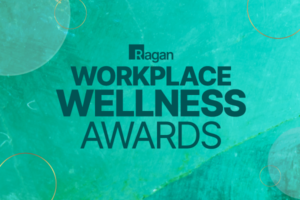Employee benefit comms: How managers make it real
The end of Mental Health Awareness month reminds us that comms and collaboration drive participation in wellness programs.

This year began with a study that shook up the billion-dollar corporate wellness industry.
Published in the Industrial Relations Journal, the study by Oxford fellow William J. Fleming suggested that employees who opted into corporate wellness benefits offered by HR, such as personal coaching sessions and mindfulness training, reported no improvement in wellbeing or productivity across the 46,336 workers surveyed and 90 different interventions.
The lone exception, the study found, were those who did charity and volunteer work.
“If employees do want access to mindfulness apps and sleep programs and well-being apps, there is not anything wrong with that,” Dr. Fleming told The New York Times. “But if you’re seriously trying to drive employees well-being, then it has to be about working practices.”
While healthy, mindful working practices that facilitate wellbeing should be everyone’s responsibility, communicators play an outsized role in helping managers and leaders model the behaviors that drive wellbeing and productivity, too.
As Mental Health Awareness Month draws to a close, the psychology and mechanisms that drive these behaviors merit a closer look.
We spoke to Brooke Wilson, head of Resources for Living (RFL) at CVS Health, ahead of her session at Ragan’s Employee Experience Conference this August to learn how she works with companies to facilitate better benefits comms.
Managers are trusted partners when they make and hold space
Modeling the behaviors that let employees know wellness is a priority begins with making space for such conversations to happen — a soft skill of manager and leadership comms.
“It’s bringing transparency around mental wellbeing into how you manage and lead,” said Wilson. “It’s also setting expectations about what healthy boundaries look like — whether it’s that 2 a.m. email or helping that employee who just had a child [figure out] the right work day so they can still get their job done.”
Active listening empowers communicators to unpack what resources can best help an employee thrive.
“‘I’m stressed out’ is a lot different than asking a couple more questions to find out, ‘I’m stressed out because I’m having a caregiving issue,’” Wilson said. “That’s where management can really help them get at those nuances. Be that trusted partner where you’re really making the appropriate connections and making a difference in somebody’s life.”
Getting leaders to engage at a grassroots level
Whether your role sits in the HR function or not, it’s essential that the lead in charge of your benefit communications gets in front of leaders beyond orientation and basics.
“It’s also helping leaders demonstrate that they care about these issues,” explained Wilson.

Brooke Wilson, Head of Resources for Living, CVS Health
This means getting leaders to think about how they care for themselves, bringing mental health and wellbeing into how they lead and knowing what resources they can draw upon when they notice an employee has a need.
“It’s making the appropriate connections, because sometimes these programs can offer such a range of services. How do you tailor that message for that individual so they actually engage?”
While there’s not always a clear ROI when it comes to engaging employees around benefits and wellbeing, Wilson has seen time and again that leadership engagement ultimately contributes to a culture in which an employee feels accepted, recognized and equipped to be transparent about the challenges they face.
“Sometimes I think we miss that this is kind of grassroots stuff — how is a manager bringing it into a meeting?” she asked. “Do they have a different way of listening and connecting their employees to resources when it’s needed?”
When it comes to addressing matters of mental health, that grassroots and bespoke approach is crucial because of the sensitivity around the topics.
Wilson has found consistently that managers and leaders are often the last people who engage in services such as this.
“They take care of everybody else and sometimes neglect their own well-being,” she said. To that end, RFL has found success with training managers on self-care at work, largely focused on setting healthy boundaries that they can then model to their direct reports and colleagues.
“Being really deliberate about those kind of displays within the workplace is important,” Wilson continued. “They’re setting an expectation because their colleagues are watching them.”
Don’t brush off the power of human connection here, either. Wilson is encouraged that the managers she works with on the client side are becoming much more open to share their own story.
“That [story] might just be what they do to maintain their mental health, but it could also be a more serious story about a challenge that happened to them and their families.”
Segmenting employee personas and reaching ERGs
Wilson advocates for segmenting employee personas with wellness in mind — whether that’s understanding that one employee is a new parent, a caregiver or has specific working accommodations in line with their needs.
“Even to the level of what kinds of services might work better for a certain type of worker,” she said. “Folks who are in a distribution center can’t spend 45 minutes in a counseling session, but you know what they can do? They can do an asynchronous chat over the course of the week with a licensed counselor.”
Segmenting helps comms connect specific services to specific populations. While a formal internal audit is always best, you can also rely on exiting channels like employee resource groups (ERGs) as opportunities to identify segments and customize your messaging.
“ERGs are a huge channel for us because we can engage with employees in different ways, and sometimes they aren’t so tied to some of the limitations that come with communications from HR,” Wilson said. “It let us get in there with programs such as peer support groups where we’re actually able to tailor conversations based on who that audience is.”
Wilson shared one example of collaborating with a working women ERG, explaining how it allows for tailored programs around topics that are important to them like menopause or parenting a child with special needs.
“[You’re] having folks really connect with each other, share their own stories and using these programs along with what they’ve learned on their own.”
Refining the services you offer along a continuum
Much of Wilson’s work grapples with the pain points that many in the mental health industry are experiencing right now. There aren’t enough therapists for the number of folks who know they need one, requiring communicators and HR to get creative and lean into the other things they can do to help employees along the mental health continuum.
Wellbeing coaching has ramped up, which helps support people working toward a goal or learning new life skills that folks would traditionally rely on a therapist to learn. Peer support continues to grow, too.
“We’re connecting people that have similar lives experiences, and it allows them to learn amazing, shared techniques from each other,” Wilson said. This is especially impactful for underrepresented groups that don’t often have a voice or speak up on issues of wellness, as well as breaking the stigma of speaking about struggles such as finances.
“While some stigma is decreasing, and we may be generally more open to talking about mental health, people aren’t always comfortable talking about the real challenges they’re facing like showing up to work and worrying about how they’re going to pay their mortgage.”
This approach involves thinking about the services you offer in your EAP as satisfying pillars of wellness, which the National Institute of Health lists as physical, intellectual, emotional, social, spiritual, vocational, financial and environmental.
Financial wellness resources, for example, could help the aforementioned employee by offering a short session on understanding mortgage rates and budgeting for homeowners.
Mapping these needs along a wellness continuum reminds comms and HR alike that every employee is in a different spot on their wellness journey.
“Some folks are doing great maintaining their mental health and well-being, they’re exercising and feeling good, there’s minimal support they need,” explained Wilson.
“Then you move across the continuum into that mild to moderate need. Those folks are feeling stress and anxiety — it’s not a diagnosable condition, more that the world is complicated and they’re feeling this heightened level of stress that all of us have probably felt since the pandemic. They just need some support to help get over that barrier.”
When you move to the other end of the continuum, more advanced mental health conditions or more complex medical issues start to surface that may merit clinical treatment or supplement care they’re already receiving.
Layering in segmented needs along the continuum
Once you have your segments, understand how your wellness resources satisfy the pillars of wellness and understand the continuum, it’s time to tie them all together. Wilson cites the communications in RFL’s coaching program as an effective example of this because it homes in on the issue that each employee is trying to solve — and acknowledges that they may not know.
“We can help them identify whether it’s about building purpose or a social connection,” she said. “As we explore the realms of well-being on top of this experience, we can really get to the goals and the homework that gets this person over the hump to meet a goal or make a life change that contributes positively to their overall wellness.”
Learn from Wilson and other leaders across communications. HR and more at Ragan’s Employee Experience Conference, going down Aug. 12-14 in Nashville. Register now!







